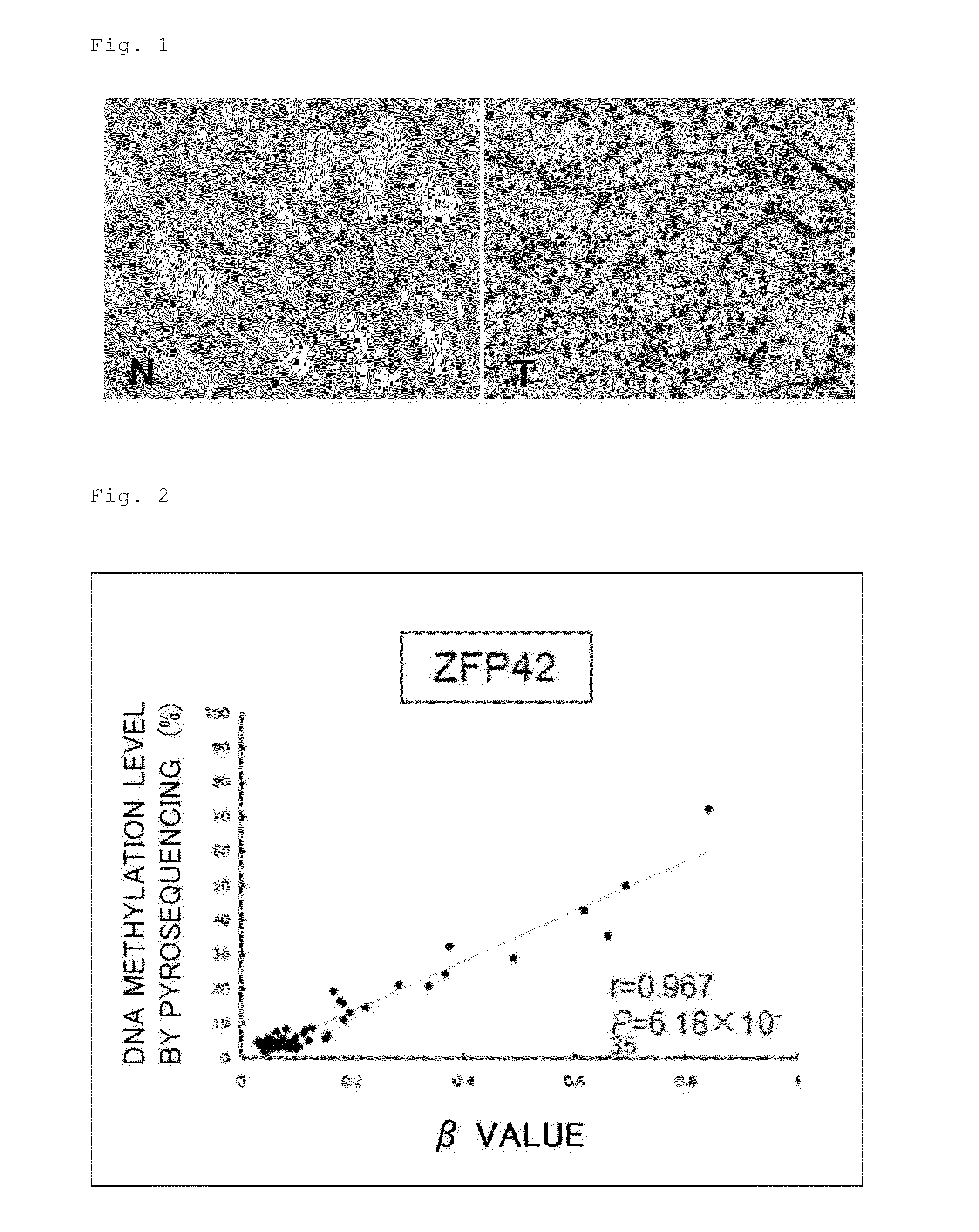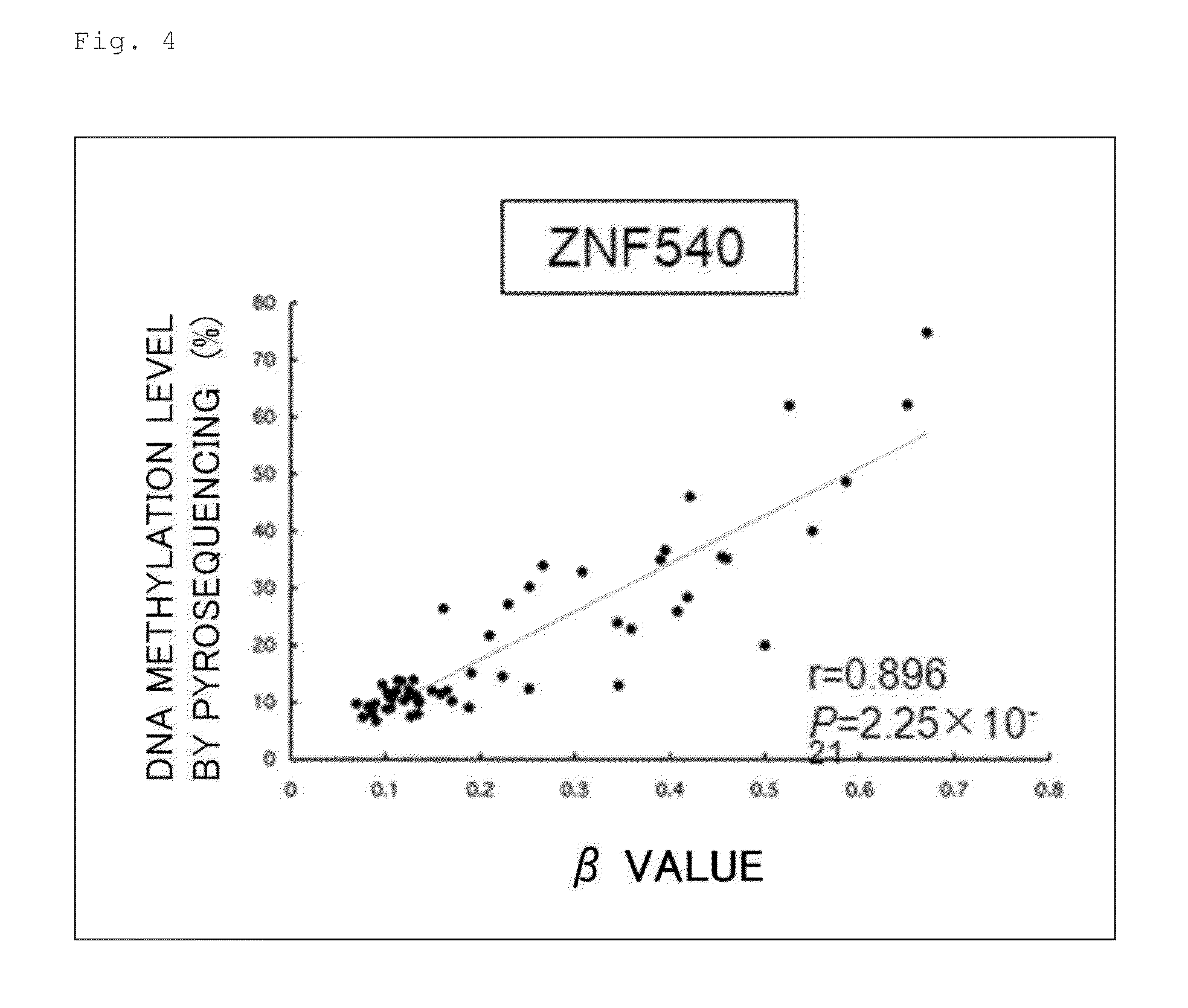Method for predicting prognosis of renal cell carcinoma
a prognosis and renal cell carcinoma technology, applied in the field of predicting the prognosis can solve the problems of mutations that cannot be fully explained, difficult to predict the prognosis using existing clinicopathological parameters, and rapid development of distant metastases, etc., to achieve the effect of determining the unfavorable prognosis risk of renal cell carcinoma, high sensitivity and specificity
- Summary
- Abstract
- Description
- Claims
- Application Information
AI Technical Summary
Benefits of technology
Problems solved by technology
Method used
Image
Examples
example 1
[0146]
[0147]First, representative CpG sites found based on the Infinium assay were verified by performing a pyrosequencing method under conditions shown in Table 9. As a result, as shown in FIGS. 2 to 4, there was a high correlation in terms of the DNA methylation level of each CpG site between the analysis results of the highly quantitative pyrosequencing method (the vertical axes in FIGS. 2 to 4) and the analysis results of the Infinium assay (the horizontal axes in FIGS. 2 to 4).
GeneTarget IDPrimerPCR conditionsZFP42cg06274159ForwardGGAGGAGTTGATGGGTGGTTGTA95° ×50 C. cy-30clessecReverseBiotin-60° CCCAAACACTCTACTATTTCCAATACCAC. 30secSe-GGGTGGTTGTAGTTTGA72° quencingC. 1minZNF154cg08668790ForwardGGAAAGTAGGTTTTTTGAGTTTTTATTGG95° ×5 95° ×5 95° ×40 C. cy-C. cy-C. cy-30cles30cles30clessecsecsecReverseBiotin-59° 57° 55° CCCTAAAACTTAAATAAACCATTTCTCATC. C. C. 303030secsecsecSe-TGAGTTTTTATTGGTTTAGTA72° 72° 72° quencingC. C. C. 1 1 1minminsecZNF540cg03975694ForwardAGGAGTAGGGTAGGGTAGAATTAGGT...
example 2
[0155]
[0156]The result of the unsupervised hierarchical clustering using the DNA methylation levels (ΔβT-N) on the 801 probes revealed that 104 patients with clear cell renal cell carcinomas were subclustered into Cluster A (n=90) and Cluster B (n=14) (see FIG. 5). Note that, as described above, the DNA methylation status at the 801 probes was altered at the precancerous stages, which was presumably involved in the renal carcinogenesis.
[0157]Next, the clinicopathological parameters of clear cell renal cell carcinomas belonging to Clusters A and B, and TNM stage were examined. Table 11 shows the obtained result.
TABLE 11Clinicopathological parametersCluster A (n = 90)ClusterB (n = 14)PAge62.08 ± 10.0867.36 ± 11.068.36 × 10−2 (b)SexMale63115.47 × 10−1 (c)Female273Tumor diameter (cm)5.10 ± 3.198.75 ± 2.851.07 × 10−4 (b)Macroscopic configurationType 13716.29 × 10−4 (c)Type 2292Type 32411Predominant histologicalG14718.33 × 10−6 (c)grades (d)G2354G377Highest histologicalG1805.67 × 10−4 (c)...
example 3
[0162]
[0163]Next, the proportions of probes showing various degrees of DNA hypermethylation in T samples compared to the corresponding N samples (ΔβT-N>0.1, 0.2, 0.3, 0.4, or 0.5) for all 26454 probes were analyzed. Moreover, the proportions of probes showing various degrees of DNA hypomethylation in N samples compared to the corresponding T samples (ΔβT-N<−0.1, −0.2, −0.3, −0.4, or −0.5) for all 26454 probes were analyzed. FIGS. 8 to 12 show the obtained result.
[0164]As apparent from the result shown in FIGS. 8 to 12, the probes showing prominent DNA hypomethylation (ΔβT-NT-NT-N>0.1, 0.2, 0.3, 0.4, or 0.5).
[0165]Thus, it was revealed that renal cell carcinomas belonging to Cluster B were characterized by accumulation of DNA hypermethylation.
[0166]Further, Tables 12 and 13 shows the top 61 probes on which DNA methylation levels differed markedly between Clusters A and B. Note that, in Tables 12 and 13, “target ID” indicates the probe number for the Infinium HumanMethylation27 Bead A...
PUM
| Property | Measurement | Unit |
|---|---|---|
| length | aaaaa | aaaaa |
| mass spectrometer | aaaaa | aaaaa |
| β | aaaaa | aaaaa |
Abstract
Description
Claims
Application Information
 Login to View More
Login to View More - R&D
- Intellectual Property
- Life Sciences
- Materials
- Tech Scout
- Unparalleled Data Quality
- Higher Quality Content
- 60% Fewer Hallucinations
Browse by: Latest US Patents, China's latest patents, Technical Efficacy Thesaurus, Application Domain, Technology Topic, Popular Technical Reports.
© 2025 PatSnap. All rights reserved.Legal|Privacy policy|Modern Slavery Act Transparency Statement|Sitemap|About US| Contact US: help@patsnap.com



